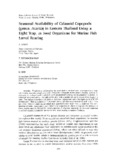Seasonal availability of calanoid copepods (genus Acartia) in eastern Thailand using a light trap, as food organisms for marine fish larval rearing
- Global styles
- MLA
- Vancouver
- Elsevier - Harvard
- APA
- Help
Share
Abstract
Zooplankton collected by the torch lighting method were investigated in a tropical coastal seawater pond in eastern Thailand. Copepods of the genus Acartia, such as A. sinjiensis, A. erythaea and A. pacifica, were predominant among the zooplankton collected. A. sinjiensis occurred almost throughout the year with a prolonged peak season from August to April. The highest abundance of adult A. sinjiensis aggregated under the light reached 35,700 individuals•l-1. The occurrence of A. erythaea and A. pacifica was intermittent with a short-term peak from March to April, during which their abundance was higher than A. sinjeinsis. The combination of water temperature and salinity was suggested to affect or regulate the biomass of these Acartia species. Among the Acartia species, A. sinjiensis seems to be the most important as a food organism available for marine fish larval rearing in eastern Thailand.
Suggested Citation
Ohno, A., Singhagraiwan, T., & Doi, M. (1996). Seasonal availability of calanoid copepods (genus Acartia) in eastern Thailand using a light trap, as food organisms for marine fish larval rearing. Asian Fisheries Science , 9(3), 231-234. http://hdl.handle.net/10862/1568
Type
ArticleISSN
0116-6514Collections
- Journal Articles [1229]


